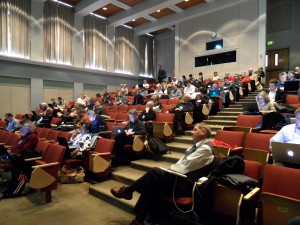
Physics and detector audience listens to Sakue Yamada's talk via videoconference during ALPCG11. Image: ILC
In late 2009, the physics common task group (CTG) proposed a set of new benchmark reactions, which were needed in the work-plan towards the Baseline Design Report. They were chosen to demonstrate the physics possibilities of the ILC and the capability of the detectors, and were based on various physics prospects. The list included a few physics reactions at one teraelectronvolt (TeV) in view of an energy upgrade in future. The two validated detector groups, ILD (International Large Detector) and SiD (Silicon Detector), considered the proposed list in view of their plans for practical simulation works. The International Detector Advisory Group (IDAG) also examined the list when it met in March 2010, together with representatives of the detector groups, the software CTG and the physics CTG. Knowing that the resources of the detector groups are rather limited to extensively tackle the proposed reactions, IDAG pointed out that the large amount of simulation prepared for the Letters of Intent (LOIs) already satisfied much of the purpose and too much elaboration would not be necessary. Yet IDAG suggested adding a new physics channel, the W-pair production at one TeV, which can bring interesting physics and demonstrate the performance of the detectors at high energy in forward and rear directions.
Last September, we formed a task force to revisit the new benchmark list and to organise work for simulation under a realistic environment. It consisted of members representing the ILD group (Mikael Berggren), the SiD group (Tim Barlow), the software CTG (Norman Graf, Akiya Miyamoto) and the physics CTG (Keisuke Fujii, Michael Peskin, Georg Weiglein), with Michael Peskin as convener. The task force made a report last January, which resolved plans for simulation exercises and included detailed simulation conditions. It suggested adding three benchmarks at one TeV. These include two channels to measure Higgs branching ratios to various final states and W-pair production, as IDAG suggested. The task force foresees a challenge in identifying some of the channels that produce many hadron jets in the final state. To perform these simulations, the detector groups need to implement realistic detector configurations and beam background conditions. They will also need to know precisely the realistic physics background, which may mimic signal channels, and make many simulations for standard model reactions.
As for lower-energy reactions, each group will repeat one of the already-studied channels with its final detector configuration. This will check the consistency against the LOI simulations. Our hope is that the LOI simulations will prove to have been good enough compared to the one with the final detector configuration.
The output of these simulations will be presented in the Detailed Baseline Design Report (DBD), in which there should be a physics chapter where the ILC physics case is illustrated. A physics volume of the Global Design Effort’s Reference Design Report was already published in 2007, and we are going to include some of the LOI reactions in an interim report, which is under editing now, to update it. The physics chapter of the DBD needs to be organised in such a way that it does not overlap much with the existing publications but that it illustrates the entire ILC physics case clearly and includes new simulations. Michael Peskin volunteered to organise the writing of this chapter together with the physics CTG members and additional volunteers. Some preparatory considerations are ongoing.
The physics CTG has already thought about various possible physics scenarios, for instance, in order to list desired benchmarks. We are now in the new stage that Large Hadron Collider is taking data with proton-proton collisions at seven TeV, and it is very likely that there could be a new finding before we complete the DBD. Under such a situation, the physics common task group will be prepared to judge any news. While the studies accomplished so far by the groups cover quite a wide range of possibilities, we need to be flexible about where we should put more weight in the physics chapter. Such new findings at the LHC will affect the strategy in how to realise the project too. In that sense the ongoing detailed study of the group can provide extremely important output not only for the DBD but also for making a strategy beyond the DBD.


Recent Comments